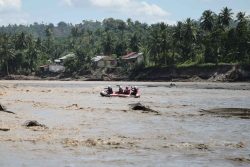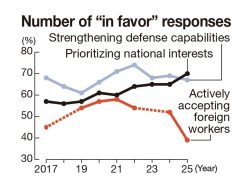Few Suitable Sites Left in Noto Peninsula to Build Temporary Housing; Disaster-Related Death a Concern Ahead of Winter
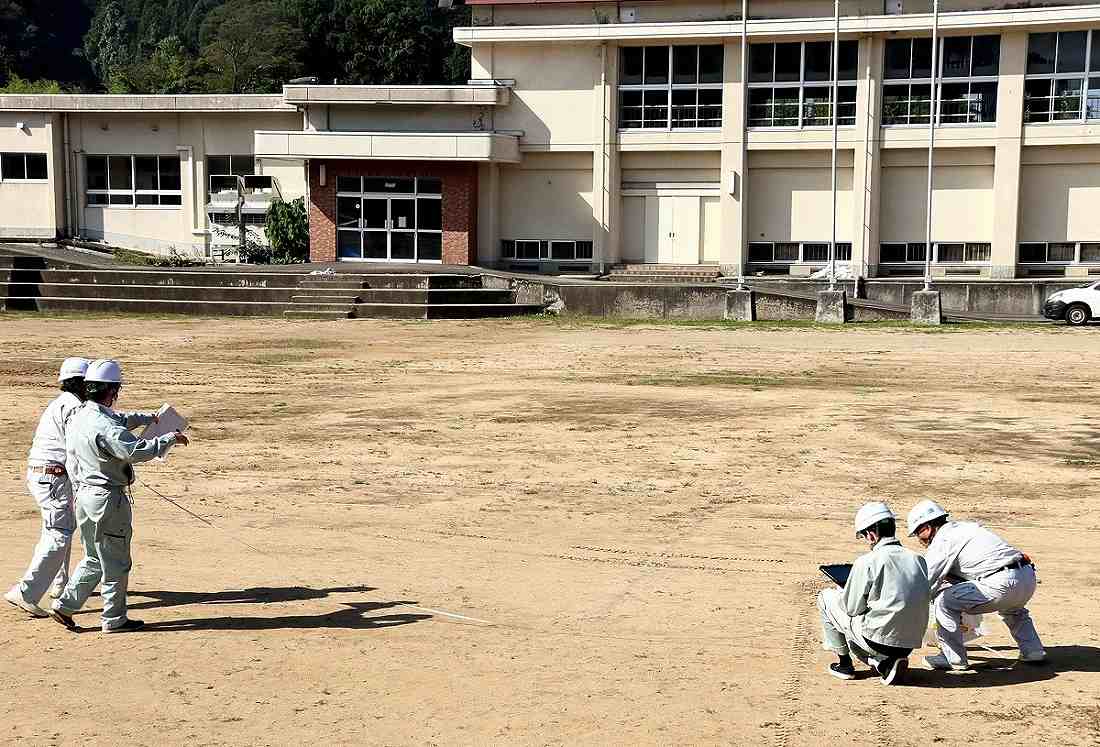
Workers conduct measurements on the grounds of an elementary school in Wajima, Ishikawa Prefecture, on Friday, in preparation for building new emergency temporary housing there.
6:00 JST, October 22, 2024
One month after torrential downpours hit northern Noto Peninsula in Ishikawa Prefecture, authorities are struggling to secure suitable sites for building new temporary housing units for those who have lost a place to live.
The heavy rains on Sept. 21 inundated some of the temporary housing built after the major earthquake that struck the peninsula on New Year’s Day, forcing those living there to move, some back into to evacuation shelters once again.
With the difficulties authorities are facing in finding suitable sites, evacuees will likely have to wait until next year for the completion of new temporary housing.
The arrival of the winter will also raise concerns of potential disaster-related deaths.
Successive disasters
“The flooding followed the earthquake in the same year,” said Junzo Yoshino, 84, in Wajima. His house was completely destroyed in the Jan. 1 quake. After staying at an evacuation shelter and friends’ houses, he finally settled in a temporary housing unit in May. But just four months later, he once again lost a place to live.
The city government recommended Yoshino evacuate to Nanao City, but he does not intend to do so partly because his family doctor is in Wajima. He is also very much attached to the city where he was born and grew up. After the Jan. 1 quake, he moved to a hotel from a shelter, but he felt uneasy in a small room and soon felt like coming back to Wajima. Following the torrential downpours, he has been staying with acquaintances and in a garage he rented to store his household belongings because he finds it difficult to sleep at an evacuation shelter. “I don’t know what to do,” he said.
Geographic challenges
The Ishikawa prefectural government plans to repair some of the inundated temporary housing units so that they can continue to be used. It also intends to make new temporary housing available for those whose houses were damaged by the heavy rains.
A total of 390 requests for temporary housing were made in Wajima and Suzu cities. Construction work for 116 temporary units started at two locations in Wajima on Friday.
Since January, the two cities have been building a total of 4,557 temporary housing units for those affected by the Jan. 1 quake. As of Tuesday last week, 31 remain uncompleted in Wajima and 241 in Suzu. Work has been stymied by the peninsula’s rugged geography – there are relatively few areas of flat land, and the mountains extend close to the sea in many places.
In addition, many areas in the cities are designated landslide hazard zones and anticipated flood zones. A total of 222 temporary housing units were inundated above floor level in the downpours.
Suzu City has received requests for 100 temporary housing units. A city official bemoaned the challenge of building new accommodations, saying, “Considering the city’s hazard map, there are almost no suitable sites.”
Out of desperation, the Wajima city government began construction of temporary housing on an elementary school playground and land that had been secured to build public housing for those affected by the disasters. The city was apparently forced to use some of its limited suitable construction sites earmarked for future disasters.
In order to make the most of its limited suitable sites, the city plans to build two-story wooden temporary housing units capable of accommodating one household on each of the two floors.
“All the temporary housing for those affected by the earthquake will be completed in late October,” said a senior official of the Wajima city government. “I thought the work would be finally over …”
Disaster-related deaths
In the aftermath of the Noto Peninsula earthquake, which occurred in the middle of winter, authorities prioritized preventing disaster-related deaths. Deaths resulting from stress from living at shelters and infectious diseases were evident among elderly evacuees. So far, 185 people, including four from Niigata and Toyama prefectures, have been recognized as having died due to disaster-related causes.
Authorities aim to complete repairs to temporary housing by the end of the year, meaning that the people who were living there will have to stay at shelters or elsewhere for as long as two more months. It will take about three months for new temporary housing to be completed in Wajima, so evacuees will only be able to move in there in January at the earliest.
The psychological burden of experiencing a series of large-scale disasters is another factor that cannot be neglected. The Wajima city government is providing mental health care to about 370 evacuees staying at primary shelters, such as school gymnastic halls, in cooperation with psychological teams engaged in disaster relief operations and the prefectural government.
The question of how it will be possible to secure housing for evacuees in the future remains.
“One option may be to make use of unoccupied houses, whose number is increasing around the country,” said Prof. Yasuaki Onoda of Tohoku University. “In that case, it will become necessary to make arrangements with their owners and prepare for repair work. Authorities should consider what to do while making use of private-sector wisdom.”
"Society" POPULAR ARTICLE
-
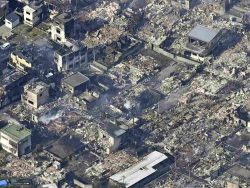
Fire Damages 170 Buildings in Oita, Western Japan
-

Tatsuya Nakadai, Japanese Actor, Dies at 92; Appeared in Films Including “The Human Condition” and “Ran” (UPDATE 1)
-
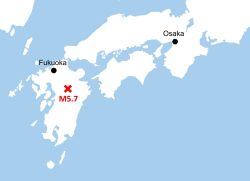
M5.7 Earthquake Hits Japan’s Kumamoto Pref., Measuring Upper 5 Intensity, No Tsunami Expected
-

Beloved Cat Stationmaster Nitama in Wakayama Pref. Passes Away at 15
-

No Easy Fix for Tokyo’s Soaring Real Estate Prices
JN ACCESS RANKING
-

Govt Plans to Urge Municipalities to Help Residents Cope with Rising Prices
-

Essential Services Shortage to Hit Japan’s GDP By Up to ¥76 Tril. By 2040
-

Japan Prime Minister Takaichi Vows to Have Country Exit Deflation, Closely Monitor Economic Indicators
-

Japan to Charge Foreigners More for Residence Permits, Looking to Align with Western Countries
-
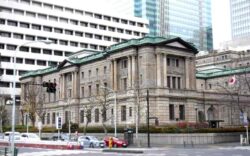
Japan GDP Down Annualized 1.8% in July-Sept.

















